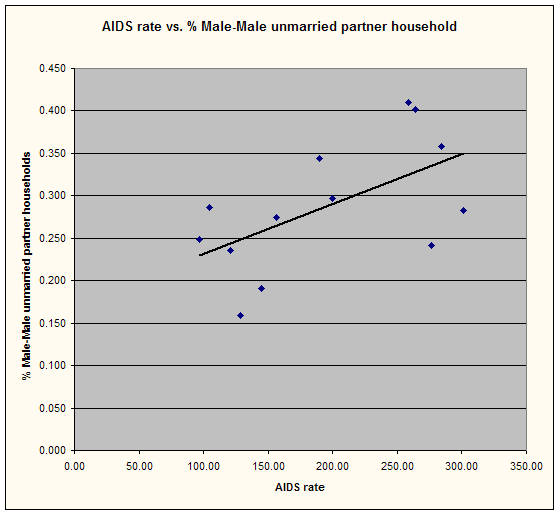
Unmarried Partner Households
Median Income and Median Family Income
There were five categories that correlated significantly with the AIDS data, and three out of the five of them were in one umbrella group, unmarried partner households. Unmarried partner households (unmarried partner households) contain two people living together who are unmarried and unrelated, but who share a close personal relationship (Census). Unmarried partner household percentages were calculated by dividing the number of the type of the unmarried partner household of interest by the total number of households in the town or city. Unmarried partner households where the unmarried partners are both male correlated with a value of .581, which is significant at the 95% confidence level. The graph of male-male unmarried partner households and the map of frequency can be seen below. The data can be found in Table 2.


Unmarried partner households where the unmarried partners are both female correlated with a value of .685, which is significant at the 99% confidence level. The graph of female-female unmarried partner households and the map of frequency can be seen below. The data can be found in Table 3.


Unmarried partner households where the partners are female and male, and the female is the head of household, correlated with a value of .594, significant at the 95% confidence level. The graph of female-male unmarried partner households and the map of the frequency can be found below. The data can be found in Table 4.


The highest r value out of these three households was calculated in the female-female unmarried partner households, which is an unexpected correlation. Females rarely transmit HIV amongst themselves, unless they are intra-venous drug users. However, only 9% of the total cumulative AIDS cases in Santa Clara County were from females, and MSM is the leading cause of transmission, not drug use. This value can be explained by calculating the correlation between the incidence of female-female unmarried partner households and the incidence of male-male unmarried partner households. They correlate significantly, with an r value of .694, indicating that there is a relationship between the prevalence of FF unmarried partner households and MM unmarried partner households, where there is a correlation between the % of MM households and the AIDS rate. The female-female unmarried partner household correlation was therefore a confounding variable. Where there are more male-male unmarried partner households, there also tend to be more female-female unmarried partner households, probably because of tolerance and presence of "gay neighborhoods." The unmarried partner households in general correlate positively with AIDS rates, which means that there must be some sort of association with higher rates of UPHs and AIDS rate. One explanation might be that perhaps those who are in unmarried partner households rather than married or single-holder households are in less stable relationships, and are therefore more likely to stray from their partners or to move on to other partners more frequently which are risk factors in HIV transmission.
The rest of the unmarried partner households, male-female and total, were not significant at the 95% level. However, the total unmarried partner household percentage correlated with AIDS rate was significant at the 90% level with an r value of .546, and conversely the total percentage of other households (such as married partner households or single holder households) was significant at the 90% level with an r value of -.546. Male-Female unmarried partner households where the male is the head of household did not correlate significantly, with an r value of .449.
The graphs of the unmarried partner households and the MF unmarried partner households can be seen below, and the data are located on Table 5.

